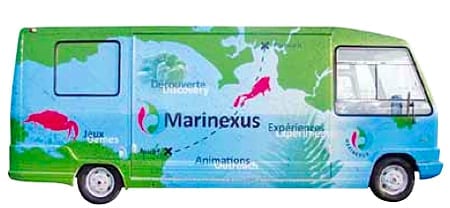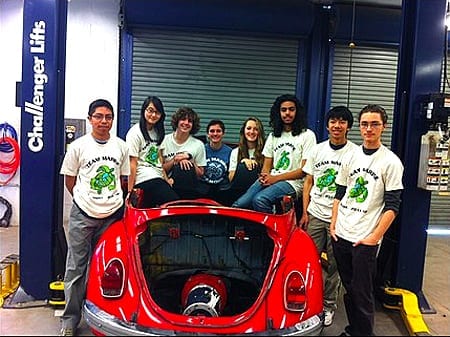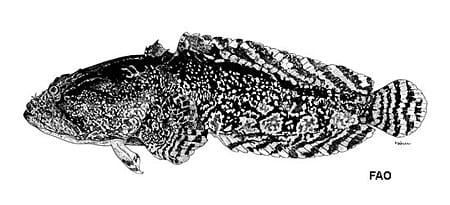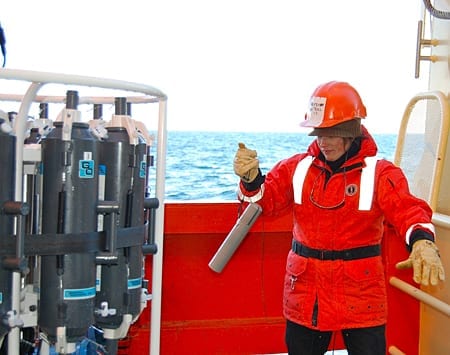By Daniel de la Calle
Inspired by our upcoming screenings for students this Thursday and Friday in the Southern Chilean town of Puerto Montt we want to post information for and about students and Ocean Acidification:
»Students from the Ridgeway School (Plymouth, UK) were commissioned by the European Project on Ocean Acidification (EPOCA) and the UK Plymouth Marine Laboratory to produce an animation film to explain the issue of Ocean Acidification to young people. They talked to scientists, conducted their own research both at school and in the National Marine Aquarium and were involved in the whole process of animation. The result was this 8 minute film that won the Royal Society of Chemistry’s Bill Bryson Prize.
»Last month youngsters from Ivybridge Community College,UK, and from Brest, Brittany got together and exchanged ideas and oppinions on invasive non-native species and Ocean Acidification. The event was supported by Marinexus, a cross-channel research and outreach project to bring together marine science and outreach in Devon and Brittany to raise awareness of marine ecosystems in the Western Channel and of their ability to cope with the effects of human activity.
»The classic Ocean Acidification experiment with vinegar and white chalkboard chalk carried out at the Reuben H. Fleet Science Center in San Diego, California. Easy to replicate in any school:
»Santa Monica High School’s “Car Team” students of Team Marine won First Place out of 35 high schools in the 2011-12 QuikSCience Challenge, a regional environmental science ocean stewardship competition. Since the beginning of the school year, “Car Team” students have worked to convert a 1971 red convertible Volkswagen Super Beetle into a 100 percent electric vehicle (short video). With their zero-emission car awaiting its final step (installation of the battery pack), the students’ “lesson plan on wheels” will soon be wrapped with the logos of all sponsors and showcased across Los Angeles County at schools and community events to promote cleaner alternative transportation. As part of their competition, they also went to Lincoln and John Adams Middle Schools to educate youth about the problems of and solutions to climate change and ocean acidification.
As part of the conversion process, the students have created a manual with pictures intended to help others repeat the process. Students have worked with local electric car experts, including Paul Pearson of Gas to Electric Conversions, as well as Samohi’s automotive teacher Dan Cox, and City Hall’s Rick Sikes to develop the manual.
Photo: Team Marine
SOURCE
»Links to another Acidification test you can do at home or in the class. All you will need is a red cabbage, drinking straws and very small cups. Details can be found HERE and if you prefer to watch a quick demo video of the experiment and meet a young student preparing herself to be the first person on Mars click HERE.
SOURCE
»University of Miami grad student Rachel Heuer has received a National Science Foundation Graduate Research Fellowship to study how Gulf toadfish (Opsanus beta) might cope with Ocean Acidification. 
Photo: FAO
“Her initial findings indicate that toadfish exposed to elevated CO2 levels, relevant for the near future and current upwelling regions, lose increased amounts of base from the body through the intestine. This is problematic since toadfish and other marine fishes need to retain bases to help them cope with acidic environments. Heuer’s preliminary findings suggest that this intestinal base loss negatively affects their overall pH balance and health.
“During my NSF Fellowship, I hope to build upon these findings by assessing the energetic cost and exploring the effects of long-term CO2 exposure in the Gulf toadfish. I am excited to utilize this fellowship to contribute to a rapidly expanding field of ocean acidification research,” says Heuer.”
SOURCE
»College of Charleston graduate student Jennifer Bennet is one of the recipients of the Knauss Marine Policy Fellowship this year. She earned her M.S. in marine biology and will serve at the NOAA Office of Oceanic and Atmostpheric Research Ocean Acidification Program helping scientists there optimize and standardize data collection so it can be easily translated for the public. Bennett will also engage stakeholder groups to determine their information needs for effective decision-making about Ocean Acidification impacts.
Photo (Jennifer Bennett): www.steminaction.org
SOURCE
»Finally, for those that have finished their studies and are looking for work the Imperial College London offers a 3 year Postdoc in Modelling Biodiversity Responses to Human Impact. The main research objective is to develop a rigorous global model of how local biodiversity responds to human impacts, in order to support projections of how alternative socio-political scenarios will affect global and regional biodiversity. Biodiversity data will come from published comparisons of assemblage composition along gradients of threat intensity. You will develop and populate a database of precise measures of threat intensity corresponding to the diversity data, developing new measures from remote-sensed data as necessary; you will also develop a database to hold species=92 functional trait data. You will employ advanced statistical modelling tool, such as generalized additive mixed models, to relate diversity to threat intensity. The successful candidate will work closely with Professor Andy Purvis (the Principal Investigator).
You must have a PhD in Ecology or Environmental Science or have equivalent level of professional qualifications and experience. For more details, click HERE


